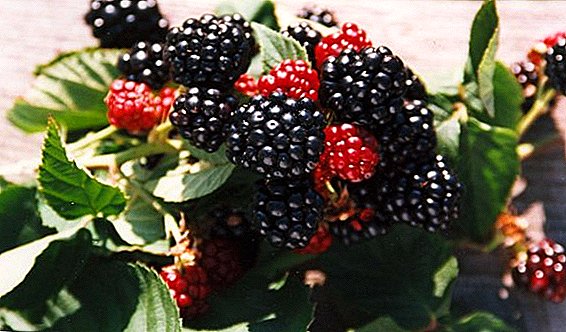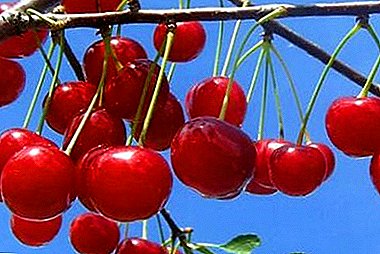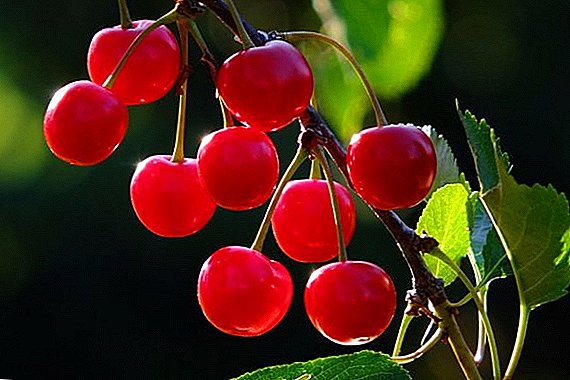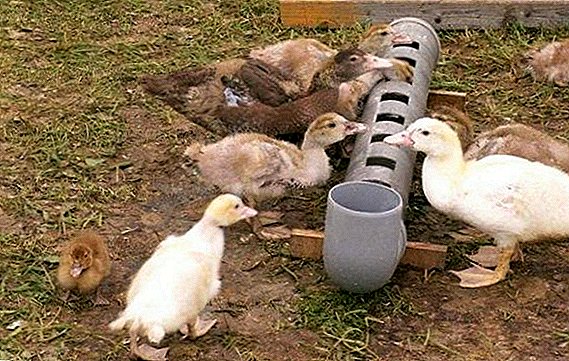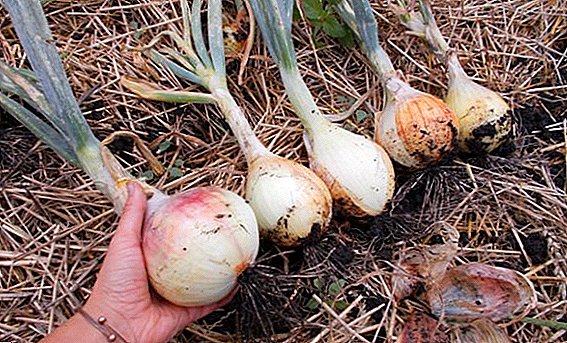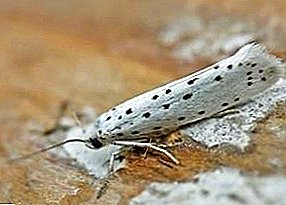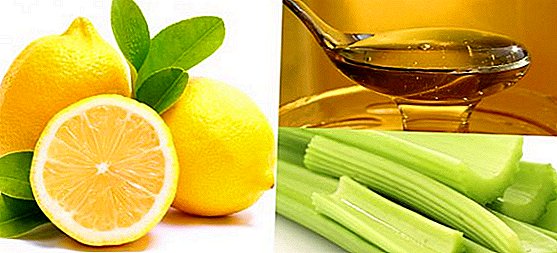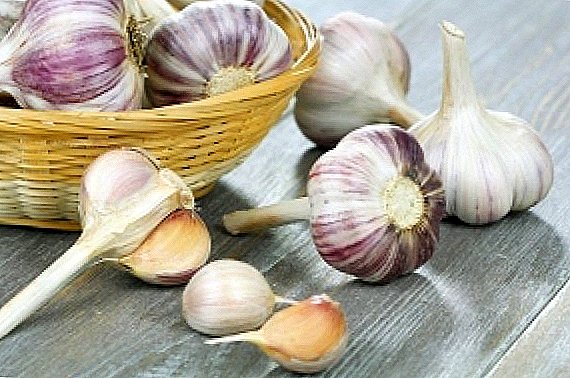
Garlic is one of the most well-known onion plants, which is both a vegetable, a spice and a medicine.
Although not everyone can call themselves fans of his spicy taste, no one can reject or challenge his healing properties.
At the same time, humanity has been growing garlic for many millennia, and for each of us it has become an ordinary plant that can be easily found in every garden.
But today we will try not to delve into how useful it is and how it is better to use it, but tell you about the secrets of planting this plant in the spring time, caring for it and protecting it from various pests.
How to fill your reserves with spring garlic: what you need to know about planting
Spring garlic is one that is planted in springtime. Usually we are accustomed to planting this plant for winter, then its yields are much higher, in terms of both quantity and quality.
At the same time, winter garlic has a much shorter longevity period - it deteriorates and dries very quickly, only in rare cases can such garlic be preserved at least until spring. For this reason, gardeners decided to try to plant this plant in the spring, thanks to which it was possible to significantly extend the storage period of its crops.
Of course, low yield, which is obtained in this way of planting, allows many to consider it as not effective, but others come to the counterbalance of such allegations, who are convinced of the higher healing properties of spring garlic.
We are preparing for planting garlic in the spring and create good conditions for its growth

As for the conditions that need to be created for the growth of garlic, two most important factors should be taken into account: the type of soil and the air temperature during planting of this plant.
As for the soil, then light types are best suited. These include light and medium loamy soils. They have the ability to easily pass moisture, but not to keep it in themselves for a long time. Also, the great advantage of such soils is their ability to saturate the garlic roots with nutrients.
It is also important how fertilized the soil is. In this regard, it is recommended to start its preparation in the autumn. In particular, a large amount of organic fertilizer is added to it, which will begin to decompose and feed the soil just in time for the growth of garlic.
Never plant garlic, especially spring, on acidic soils, which will slow down the growth and development of this plant. Such soils are advised to lime, lowering the level of acidity to 6-7 pH.
In terms of temperature conditions, it is also necessary to touch on the soil characteristics. In particular, it must be remembered that garlic belongs to cold-resistant cultures, therefore its roots are capable of starting to grow even at + 1ºС.
Of course, the most optimal temperature will be + 8-12ºС, and also at this temperature the ground part of the described plant is already able to grow. However, there is one small nuance: if the temperature of the air and the soil is high, the ground part can be far ahead of the root in growth, and then the bulb can hardly be formed. Thus, you need to be very careful with the timing of landing and in any case not to delay with them.
The sooner you plant such garlic, the better it will manifest itself. Do not be afraid that he will freeze, be afraid that he will not bring you any crop at all.
Another important condition is the presence of moisture for rooting cloves of garlic. In the absence of it, it can only be very long in the soil for a very long period of time and not grow. And most often it can happen in spring, when the soil is not so much weakly saturated with moisture, as it quickly evaporates from the ground.
When exactly is the time to plant spring garlic?
Tightening with planting garlic on the territory of Ukraine or the middle climatic strip of Russia is not worth it. This is due to the fact that it grows rather slowly and simply may not have time to mature in such a short period of warm time. And given the resistance of this plant to cold, it can be planted very early.
However, usually this process is carried out under the completion of the second decade of April or at the beginning of the third. That is, it will be ideal to plant garlic from April 7 to 14. Of course, each spring is different in its periods of frost retreat and heat, therefore sometimes garlic is planted earlier in spring. In the latter case, the yields obtained will be virtually no different from winter garlic.
What is special in preparing the soil for garlic: sharing secrets and key rules

We already mentioned the kind of soil according to its type that we need to plant garlic. However, in agriculture no less important issue is the change of crops on the soil. In particular, garlic is by no means recommended to be grown in the same place where it grew last year, or onions, or even potatoes. It is more acceptable that he was planted after cucumbers, zucchini or cabbage. In this case, the soil will not be severely ruined in terms of garlic nutrients.
You can start cooking the soil for garlic in the fall, carefully digging it up and fertilizing it with organic matter. However, in the autumn it will still have to be processed again. At least a day before planting, she also digs up, and the digging should be deep, for the whole of the bayonet of the shovel. In the process, it also removes the remains of all last year’s weeds from the soil, and those that have already managed to grow this year. In general, the soil well prepared for planting garlic should be well loosened, clean and leveled.
Do not forget to share one more secret: before spring planting of garlic, it is recommended to water the soil with a solution of ordinary table salt. For this, only 3 tablespoons of this fertilizer is diluted into a bucket of water. After that, the whole area on which you are going to plant your garlic is poured with this water. It serves not only as a fertilizer, but also protects the plant from various pests.
Preparing for planting garlic itself: what material will be more successful?
We think that everyone knows how garlic multiplies. This is done with the help of his teeth, which are planted in the soil, germinate and form a full-fledged head of this plant. But in order for all this to happen successfully, it is worthwhile to properly prepare the initial planting material - the teeth themselves.
Separating the teeth from the head, it is necessary to select the largest and thickest ones that can give a good harvest. In order to strengthen its strength for future growth, a clove is placed in warm water before planting.
Also to even better stimulate growth processes, water can be replaced with a solution of nitroammofoski. The concentration of such a solution should not be strong, usually no more than one tsp is used per bucket of water. It’s not necessary to keep them in water for a very long time, one night will be enough if you start the landing in the morning.
Let's share some more tips from experienced gardeners:
- Garlic cloves can be processed with salt or potassium permanganate before planting. These substances increase its stability and increase yield. However, even without such actions, good harvests of autumn garlic are almost always achieved.
- Garlic can be propagated with the help of seeds. They are usually formed on the arrows of the stems by the time when it is almost possible to harvest. However, in this case, the harvest will not be obtained in the year of planting. After all, only one head grows from seeds with very weak teeth, which is intended for planting next year.
Garlic planting scheme: how much space does this plant need for optimal growth?

Of course, garlic is not a big tree with a developed root system, and the area of its food can be very small. The only important thing is that before the landing itself the teeth should be re-portted again, putting the larger ones in one direction and the smaller ones in the other.
Since large teeth are able to form larger heads, they should be planted more widely. Between two teeth should leave a space of 10-12 centimeters, but between their rows - about 16-20 centimeters. The same teeth that have smaller sizes can be planted more closely, up to two times.
Such a landing scheme is quite convenient. It allows directly at harvesting to sort it on the garlic that will be used throughout the year for food and for other purposes, and one that will become seeds for planting in the future.
As for the planting of garlic in the springtime, then it is worth considering the following:
- It is not necessary to dig in the teeth too deeply, as we used to do when planting winter garlic. After all, it can significantly prolong the process of convergence of plants, delaying their growth and development. This method of planting is more similar to planting onions, if we talk about the depth of immersion of seeds in the soil - only 1-2 centimeters.
- The clove is placed in the soil, ground down, because it is from the ground in the future that garlic roots will be formed.
- Condense the soil after planting is not worth much. At the same time, spring garlic is advised not to be planted by pressing into the soil, which will consolidate the soil and will adversely affect the growth of the root system. It is best to pre-prepare shallow vertical trenches along the entire length of the row, dip the teeth in them and carefully cover them with soil.
- It is important to once again water the soil with already planted garlic, but this should be done if the soil really needs moisture.
Council gardener: the space between the rows of garlic can be used with benefit. Between the rows of this plant is often sown seedlings of cabbage or swede. Since the seedlings grow very quickly and involve a subsequent transplant, it will not bring any harm to the garlic, but will allow to save a lot with garden space.
Harvesting spring garlic: when to start and how to store?

With good care and appropriate weather conditions, spring garlic ripens without problems by the end of August or in the first decade of September, that is, much later than winter.
But still, if the weather conditions allow, and the stems do not seem dry enough for you, you can hold it in the soil for much longer. It is believed that this greatly increases the sharpness of the resulting crop.
The bulbs should be easily pulled out of the soil by the stem, but if the soil is dense and they are damaged, it is better to break it. After that, they can be dried directly in the garden, if the weather permits, or under a shelter - the main thing is that there is good air ventilation.
For storage usually remove the topsHowever, it can be saved using garlic garlands for weaving - you could see such things with your grandmothers or in the national interiors of Ukrainian huts.
Storage methods There are two garlic:
- In a warm way, in which the crop is stored at a temperature not higher than 18ºС, it is also impossible to lower it below this level.
- The cold method suggests that garlic is left in a room where the temperature is constantly around 3ºC.
We care for spring garlic: how to increase the yield and protect the plant from pests?
Although it is not difficult to care for the whole, but it must be done. The reason for this lies in the existence of a large number of pests of this plant and diseases that can damage it.
Also, with the help of the year, it is possible to significantly improve soil fertility and level the deficiencies in weather conditions.
We increase the resistance of garlic, protecting from pests and diseases

Despite the specificity of the smell and taste of the fruits of this plant, it can be damaged by so many pests and diseases. Among them are many fungal diseases, cervical rot, onion fly, black mold.
In general, garlic is able to resist them well, but it’s still worth being attentive to a plant even if there are signs of a disease - immediately take measures to combat it.
Improve sustainability of garlic can be a good feeding and regular soil loosening. Also, it is very important to select healthy material for planting, and after harvesting it should be carefully inspected, dried and disposed of damaged heads.
However, only concrete actions to control its larvae can help fight such a pest as a field fly: solutions of tobacco or salt are used.
Also interesting to read about the autumn planting garlic
We care for the soil in which the garlic grows
Caring for the soil involves its constant loosening and removal of weeds. Because of this, the roots will be much easier to develop, they will receive nutrients and moisture faster.
Weeds also pose a great danger to the grapevine, as they are able to “steal” nutrients from the soil and be sources of various diseases and pests.
Top dressing of spring garlic: which fertilizers are best to use?
Feeding garlic can begin immediately after germination, scattering a handful of humus between its rows. When the plant is already beginning to form bulbs, closer to mid-July, you can use complex fertilizers.
In particular, phosphorus and potassium are very well reflected in the growth of garlic, and superphosphate is often used. It is not necessary to use a lot of water on a bucket of water of these fertilizers: one tablespoon will be enough for the first pair, and 2 for the second. If the soil is very poor and not sufficiently fertile, then top dressing is carried out even every week, although the rate is 2 times a month.
The flow rate of the described solution should also not be made too abundant - even 3-4 liters will be enough for 1m2.
Does garlic need watering? We discuss the whims and needs of the plant.
At a time when garlic begins to grow especially intensively, the weather is usually set to very hot. And since it grows under the surface of the soil, it often lacks moisture. For this reason, watering garlic should be presented by you as an ordinary matter, which is necessarily carried out in drought.
On an area of 1m2 is used around a bucket of water. At the same time, it is recommended to irrigate only in the evening, and on the second day to loosen the soil (since water can thicken it strongly, which is not desirable).


